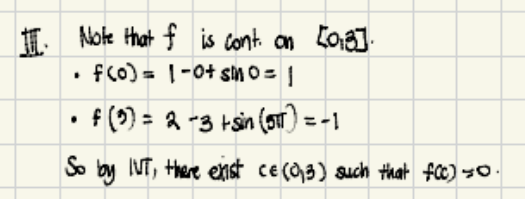Note that f is continuous on [0, 3]. f(0) = 1 - 0 + sin(0) = 1. f(3) = 2 - 3 + sin(3π) = -1. So by IVT (Intermediate Value Theorem), there exists c in (0, 3) such that f(c) = 0.

Understand the Problem
The image demonstrates the application of the Intermediate Value Theorem (IVT). It shows that a function f(x) is continuous on the interval [0, 3]. It evaluates f(0) and f(3), finding that f(0) = 1 and f(3) = -1. Because f(0) and f(3) have opposite signs, according to IVT, there must exist a value c within the interval (0, 3) such that f(c) = 0.
Answer
By the Intermediate Value Theorem, there exists a $c \in (0, 3)$ such that $f(c) = 0$.
Answer for screen readers
By the Intermediate Value Theorem, there exists a $c \in (0, 3)$ such that $f(c) = 0$.
Steps to Solve
- Function is continuous on [0,3]
The problem states that $f$ is continuous on the closed interval $[0, 3]$. This is a necessary condition for applying the Intermediate Value Theorem (IVT).
- Evaluate $f(0)$
The problem provides $f(0) = 1 - 0 + \sin(0) = 1$. Since $\sin(0) = 0$, the calculation is correct.
- Evaluate $f(3)$
The problem states $f(3) = 2 - 3 + \sin(3\pi) = -1$. Since $\sin(3\pi) = 0$, the calculation is also correct. This shows that $f(0) = 1$ and $f(3) = -1$.
- Apply the Intermediate Value Theorem (IVT)
Since $f$ is continuous on $[0, 3]$, and $f(0) = 1$ and $f(3) = -1$, then by the IVT, there exists a $c$ in the open interval $(0, 3)$ such that $f(c) = 0$. This is because $f(0)$ and $f(3)$ have opposite signs (one is positive and the other is negative, or vice-versa). The IVT guarantees a root (a value $c$ where $f(c) = 0$) within the interval $(0, 3)$.
By the Intermediate Value Theorem, there exists a $c \in (0, 3)$ such that $f(c) = 0$.
More Information
The Intermediate Value Theorem is a fundamental concept in calculus that connects the continuity of a function with its values within a closed interval. It essentially states that if a continuous function takes on two values, it must also take on every value in between. In this case, since $f(0) = 1$ and $f(3) = -1$, the function must take on the value 0 at some point $c$ between 0 and 3.
Tips
A common mistake is forgetting that the function must be continuous on the closed interval to apply the IVT. Also, the IVT only guarantees the existence of a value $c$, it doesn't tell us how to find it. Furthermore, one should be careful when evaluating trigonometric functions, and remember that values such as $\sin(n\pi)$ where n is an integer, equal 0.
AI-generated content may contain errors. Please verify critical information